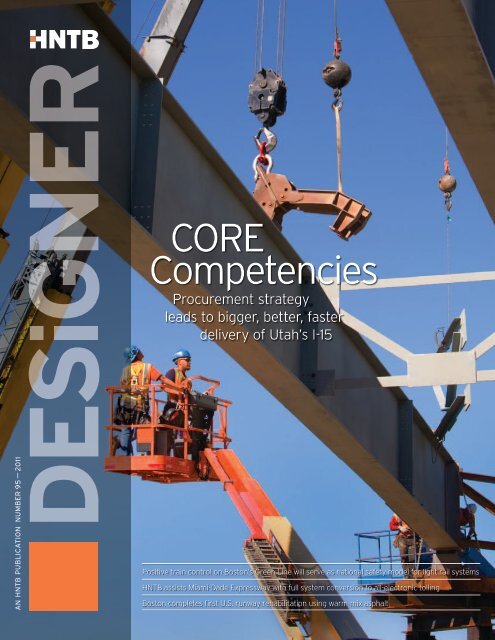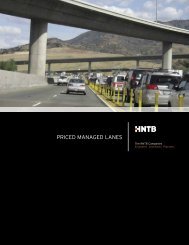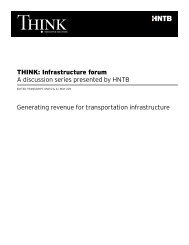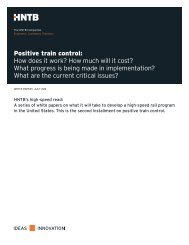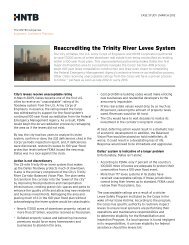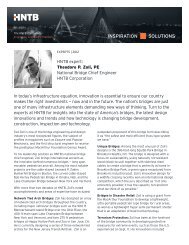Procurement strategy delivers for Utah I-15 CORE
Procurement strategy delivers for Utah I-15 CORE
Procurement strategy delivers for Utah I-15 CORE
You also want an ePaper? Increase the reach of your titles
YUMPU automatically turns print PDFs into web optimized ePapers that Google loves.
<strong>CORE</strong><br />
Competencies<br />
<strong>Procurement</strong> <strong>strategy</strong><br />
leads to bigger, better, faster<br />
delivery of <strong>Utah</strong>’s I-<strong>15</strong><br />
An HNTB Publication Number 95 — 2011<br />
As seen in HNTB DESIGNER Number 95 — 2011<br />
hntb.com | © 2011 HNTB Companies. All rights reserved.<br />
Positive train control on Boston’s Green Line will serve as national safety model <strong>for</strong> light rail systems<br />
HNTB assists Miami-Dade Expressway with full system conversion to all-electronic tolling<br />
Boston completes first U.S. runway rehabilitation using warm-mix asphalt
<strong>CORE</strong><br />
Competencies<br />
As seen in HNTB DESIGNER Number 95 — 2011<br />
hntb.com | © 2011 HNTB Companies. All rights reserved.
As the largest road project in state history, <strong>Utah</strong>’s I-<strong>15</strong> <strong>CORE</strong> reconstruction program could<br />
have fallen victim to change orders and missed deadlines. Instead, a unique procurement<br />
<strong>strategy</strong>, rigorous project controls and the right team have contributed to the project<br />
being completed two years ahead of schedule with double the number of freeway lane<br />
miles and three additional interchanges — all while staying under budget.<br />
Sporting a price tag of $1.725 billion, the 24-mile reconstruction<br />
of Interstate <strong>15</strong>, <strong>Utah</strong>’s primary north-south corridor, is the<br />
largest road construction project in state history, the largest<br />
project under way in the western United States and one of the<br />
three largest projects in the country.<br />
The state-funded I-<strong>15</strong> Corridor Expansion Project, also known<br />
as I-<strong>15</strong> <strong>CORE</strong>, is even more impressive when you consider<br />
that the project scope has grown, but the budget hasn’t. The<br />
<strong>Utah</strong> Department of Transportation, along with program<br />
management consultant HNTB, was able to double the number<br />
of reconstructed miles, add three more interchanges and trim<br />
two years off the required schedule — all staying within the statefunded<br />
budget of $1.725 billion.<br />
The I-<strong>15</strong> <strong>CORE</strong> project will:<br />
• Add a total of 24 miles in both directions.<br />
• Extend the high occupancy toll (HOT) lane<br />
a total of five miles in both directions.<br />
• Rebuild and reconfigure 10 freeway interchanges.<br />
• Replace 59 aging bridges.<br />
“The combination of construction being on sale because of<br />
the slow economy, along with the very proactive procurement<br />
<strong>strategy</strong> led by HNTB, resulted in the state getting a better,<br />
more extensive project than earlier estimates predicted,” said<br />
Dal Hawks, UDOT project director.<br />
HNTB brings more than 50 years of program management<br />
consulting experience and a comprehensive range of services to<br />
the project. Among its core competencies are a fixed-price/bestdesign<br />
procurement <strong>strategy</strong> and a rigorous set of project controls.<br />
PROCUREMENT STRATEGY<br />
DELIVERS GREATEST VALUE<br />
After UDOT tapped HNTB to provide program management<br />
consulting services, the state legislature cut the budget <strong>for</strong> the<br />
project. Instead of having $2.63 billion, the agency was now<br />
working with $1.725 billion. Knowing UDOT’s goal was to<br />
deliver the highest value project possible to the public, HNTB<br />
recommended the agency change its procurement <strong>strategy</strong> from<br />
a standard, design-build approach to a federally accepted fixedprice/best-design<br />
procurement to help stretch state dollars and<br />
give taxpayers more <strong>for</strong> their money. Under this approach, the<br />
UDOT team established the design-build contract value at<br />
$1.1 billion and defined acceptable design parameters. Then they<br />
encouraged the three competing design-build proposers to be<br />
creative and innovative as they individually developed their<br />
proposals and defined specifically their scope, schedule and<br />
approach to how they would handle traffic during construction.<br />
“Because we set the price,<br />
the design-build teams were<br />
able to really focus their creative<br />
energy on meeting the goals<br />
of the project that were most<br />
important to us,” Hawks said.<br />
The unique procurement<br />
<strong>strategy</strong> fostered fierce<br />
competition among design-build<br />
teams, who battled to deliver the<br />
greatest value <strong>for</strong> the price by<br />
proposing innovative concepts,<br />
economies of scale and<br />
optimized schedules. UDOT<br />
scored each proposal based on<br />
recommended improvements,<br />
traffic management during<br />
construction and schedule<br />
completion.<br />
Provo River Constructors was<br />
chosen <strong>for</strong> the job. The team’s<br />
winning proposal included:<br />
• Using 40-year concrete<br />
pavement along the entire<br />
corridor.<br />
• Adding approximately 12 miles<br />
of travel lanes in addition to the 12 required.<br />
• Keeping the current number of traffic lanes<br />
open during the majority of construction.<br />
• Delivering the project by December 2012,<br />
two years earlier than required.<br />
Collaborative<br />
Delivery<br />
HNTB’s PMC services <strong>for</strong> the<br />
I-<strong>15</strong> <strong>CORE</strong> project include:<br />
• <strong>Procurement</strong><br />
• Risk analysis and Monte<br />
Carlo assessment<br />
• Project controls/systems<br />
• Baseline survey control<br />
• Preliminary design<br />
• Utility investigation<br />
• Master utility agreements<br />
• Right-of-way acquisition<br />
• Third-party agreements<br />
• Contract administration<br />
• Design and construction<br />
oversight and auditing<br />
• Project management<br />
• Safety oversight<br />
• Communication<br />
and public outreach<br />
• Quality oversight<br />
• Human resources<br />
• Funding scenarios<br />
>><br />
“This is the first time UDOT has procured a project of this size<br />
using the fixed-price/best-design method,” Hawks said. “It has<br />
allowed us to meet our goals at the highest level possible.”<br />
The project is expected to meet traffic demands through 2030.<br />
As seen in HNTB DESIGNER Number 95 — 2011<br />
hntb.com | © 2011 HNTB Companies. All rights reserved.
A program management consultant touches every aspect of a large<br />
transportation program. HNTB uses project controls to deliver the greatest<br />
value and make sure budgets and schedules are on pace to complete each<br />
phase of the program within the client’s expectations.<br />
PROJECT CONTROLS ELEVATE<br />
PROJECT MANAGEMENT<br />
To monitor all the moving parts of the immense project,<br />
HNTB instituted a set of project controls to proactively manage<br />
schedules, costs and documents.<br />
“Project controls help us identify an issue and address it be<strong>for</strong>e<br />
it becomes a legitimate concern that negatively impacts the budget<br />
or schedule,” said John Bourne, HNTB program manager.<br />
QualityMatters!, a customized audit and quality-tracking tool<br />
designed by HNTB, was intended <strong>for</strong> immediate use on the I-<strong>15</strong><br />
<strong>CORE</strong> project but is applicable to other design-build or publicprivate<br />
partnership projects. QualityMatters! encompasses three<br />
distinct quality management systems:<br />
1. Requirements management<br />
system (RMS) was used to<br />
develop the request <strong>for</strong> proposals<br />
and procurement documents.<br />
HNTB’s goal was to clearly,<br />
concisely communicate contract<br />
requirements so they are en<strong>for</strong>ceable,<br />
understandable and measurable.<br />
“Engineers write requirements<br />
in terms that they understand, but<br />
contract language, such as anticipate,<br />
expect, maximize and consider,<br />
aren’t measurable or en<strong>for</strong>ceable,”<br />
Bourne said. “The requirements<br />
management system helped us draft<br />
contract language that is clear to the<br />
people who would be conducting<br />
the oversight and clear to the<br />
people who are writing proposals <strong>for</strong> the project so that when<br />
they are building the work, there are fewer opportunities <strong>for</strong><br />
disagreement.”<br />
HNTB also insisted on a consistent structure <strong>for</strong> the requests<br />
<strong>for</strong> proposals. So, the firm created a requirements breakdown<br />
<strong>CORE</strong> Facts<br />
What does it take to build one of the nation’s<br />
largest road reconstruction projects<br />
9,000 orange barrels<br />
2 million cubic yards of roadway excavation<br />
7.5 million tons of aggregate/granular material<br />
3.75 million square yards of asphalt paving<br />
96 million pounds of structural and rein<strong>for</strong>cing steel<br />
Nearly 1,000 men and women directly employed<br />
on the project with an anticipated 2,000<br />
or more directly employed at the height of the<br />
construction<br />
More than 520,000 employee hours on the<br />
project since the start of construction<br />
structure — or list of requirements by functional groups,<br />
organized consistently in the RFP. In addition, each of the RFP’s<br />
19 technical sections was organized the same way, starting with<br />
general in<strong>for</strong>mation, then standards and requirements. Armed<br />
with a user-friendly RFP, design-build teams better understood<br />
the contract requirements and, <strong>for</strong> that reason, did not add<br />
unnecessary dollars to cover risks.<br />
“Plus, once you administer the contract, with its many<br />
thousands of requirements, the owner and the design-builder<br />
want to be able to consistently confirm that requirements are<br />
being met,” Bourne said. “This RFP structure makes that task<br />
easier and helps eliminate conflicting requirements in different<br />
RFP sections.”<br />
2. Verification management system (VMS) allows<br />
the owner to audit the design-builder against the contract<br />
requirements and commitments made in their proposal<br />
that exceed RFP requirements. The<br />
VMS combines the RFP requirements<br />
and the proposal commitments into<br />
a searchable database from which<br />
audit checklists can be developed by<br />
the owner’s team to confirm contract<br />
requirements have been met.<br />
The VMS is an internet-based,<br />
customized SharePoint application<br />
that allows the owner and contractor<br />
to interact entirely online as audits are<br />
conducted. Audits are initiated by <strong>CORE</strong><br />
construction oversight staff and assigned<br />
to their Provo River Constructors<br />
counterparts. Audits cover both the<br />
contractor’s established processes (such<br />
as their quality management plan) and<br />
products (such as final design drawings<br />
or constructed work). Email alerts with embedded links to audit<br />
<strong>for</strong>ms notify both parties when action or approval is required<br />
at each step of the resolution process. All non-con<strong>for</strong>mances<br />
identified in an audit must be addressed and resolved to the<br />
satisfaction of the owner be<strong>for</strong>e subsequent work can<br />
be completed or payment is made. (continued)<br />
As seen in HNTB DESIGNER Number 95 — 2011<br />
hntb.com | © 2011 HNTB Companies. All rights reserved.
“You can do the best job in the world translating expectations<br />
into requirements and making those requirements clear,<br />
understandable and verifiable — but if there are no consequences<br />
<strong>for</strong> noncompliance, it’s all <strong>for</strong> naught,” Bourne said. “In some<br />
cases, those consequences are nonpayment or liquidated damages.”<br />
“QualityMatters! gives us a targeted auditing approach that<br />
ties directly back to the contract requirements and proposal<br />
commitments,” Hawks said. “So, we can have confidence<br />
that the design-builder is meeting all of those requirements.”<br />
In addition, an “opportunity <strong>for</strong> improvement” (OFI)<br />
comment may be identified by an auditor that, if incorporated,<br />
may potentially improve a process or system. While only a<br />
suggestion, all OFI comments must be addressed by the designbuilder.<br />
“Ninety-five percent of the OFI comments we make are<br />
accepted by the design-builder because we involved auditing<br />
early in the design process,” Bourne said. “If they disagree<br />
with a suggestion, then we need to determine if it’s something<br />
we believe is best <strong>for</strong> the project and want to push <strong>for</strong>.”<br />
3. Acceptance management system (AMS) facilitates<br />
efficient project closeout by identifying and confirming that<br />
work has been per<strong>for</strong>med and accepted as it is completed rather<br />
than waiting until the end of the project.<br />
The AMS is essentially a giant automated checklist that<br />
combines audit findings from VMS, results of the contractor’s<br />
quality assurance testing and items from a Sharepoint-based<br />
project punch list to track each geographic work zone’s readiness<br />
<strong>for</strong> opening and acceptance. Once all requirements have been<br />
met, all submittals have been recorded, all non-con<strong>for</strong>mances<br />
have been resolved and all punch list items closed out, the AMS<br />
tracks the work zone’s status and days of remaining warranty.<br />
“The system allows us to work hand-in-hand with the designbuilder,<br />
eating the elephant in pieces rather than all at once,”<br />
Bourne said. “At project closeout, there are no surprises and<br />
we can get the facility turned over to the owner more efficiently<br />
with significantly less cost and frustration to the design-builder.”<br />
The acceptance management system expedites the commissioning<br />
process by identifying and resolving issues early and eliminating<br />
those issues that can crop up at the end of the project.<br />
“From the time the budget was established and we laid out our<br />
procurement schedule in early 2009, we have hit every targeted<br />
deadline. That’s a tough thing to do, especially on large public<br />
works projects,” Hawks said. “I attribute our success to having<br />
the right team, the right approach and the right controls. HNTB<br />
and their partner companies have not only met but exceeded<br />
UDOT’s expectations.” n<br />
CONTACT:<br />
John Bourne, HNTB Program Manager<br />
(801) 341-6413 n jbourne@hntb.com<br />
HNTB’s I-<strong>15</strong> <strong>CORE</strong> PMC team<br />
Member: John Bourne<br />
Title: Program manager<br />
Role: Bourne oversees and manages the project<br />
team, which consists of approximately<br />
100 consultants in engineering, financial<br />
analysis, procurement, contract administration, public<br />
in<strong>for</strong>mation, quality, right-of-way, utility, cost estimation<br />
and risk analysis, design and construction oversight and<br />
auditing and compliance verification and reporting.<br />
Importance: As part of a demanding political and technical project, a<br />
program manager develops, organizes and streamlines<br />
work to ensure the client is being properly supported with<br />
the appropriate and necessary technical expertise.<br />
Member: Julia Wilkins<br />
Title: Deputy program manager<br />
Role: Wilkins manages and oversees the<br />
systems, document control, safety,<br />
business and finance, human resources<br />
and administrative functions <strong>for</strong> the program. She also<br />
provides general support to the program manager.<br />
Importance: On a project of this magnitude, overseeing and managing<br />
these functions is essential to ensuring design-builder<br />
compliance with contract requirements.<br />
Member: Doug Calder<br />
Title: Quality manager<br />
Role: Calder develops, implements and<br />
maintains quality management systems<br />
and procedures to ensure I-<strong>15</strong> <strong>CORE</strong><br />
meets and exceeds UDOT’s requirements and expectations.<br />
Importance: Establishing and continually improving quality<br />
management best practices ensures that contract<br />
requirements are met, due diligence is per<strong>for</strong>med and<br />
UDOT not only gets what it is paying <strong>for</strong>, but also receives<br />
additional value beyond the contract requirements.<br />
Member: Clint Ells<br />
Title: Contract administration manager<br />
Role: Ells oversees the project controls and<br />
contract administration, which consist of<br />
schedule management, cost and budget<br />
management, risk management, change<br />
management, project correspondence and workflow.<br />
Importance: Project controls and contract administration have a<br />
direct impact on budget, scope and schedule. Oversight<br />
and management of these areas is essential to ensure<br />
compliance with contract requirements and proposal<br />
commitment.<br />
Member: Pete Marshall<br />
Title: In<strong>for</strong>mation technology systems manager<br />
Role: Marshall develops and maintains IT<br />
systems and solutions <strong>for</strong> automating<br />
project workflows and processes,<br />
including project controls that monitor<br />
the contractor’s per<strong>for</strong>mance.<br />
Importance: Customized project controls tools add value to the project.<br />
They allow the oversight team to focus on the contractor’s<br />
key activities to ensure all contract requirements, including<br />
proposal commitments, are achieved.<br />
As seen in HNTB DESIGNER Number 95 — 2011<br />
hntb.com | © 2011 HNTB Companies. All rights reserved.


